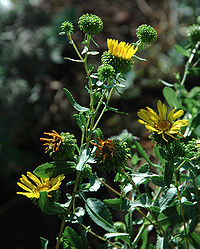Grindelia
| Grindelia subsp. var. | Gum plant, Rosin weed, Tar weed | |||||||||||||||||||||||||||||||||||||||||||||||||||||||
|---|---|---|---|---|---|---|---|---|---|---|---|---|---|---|---|---|---|---|---|---|---|---|---|---|---|---|---|---|---|---|---|---|---|---|---|---|---|---|---|---|---|---|---|---|---|---|---|---|---|---|---|---|---|---|---|---|

|
|
| ||||||||||||||||||||||||||||||||||||||||||||||||||||||
| ||||||||||||||||||||||||||||||||||||||||||||||||||||||||
Grindelia is a genus of plants native to the Americas belonging to the family Asteraceae, (Compositae). G. squarrosa, a plant with bright yellow flowers indigenous to much of the United States, is commonly called curlycup gumweed. G. robusta, found in the western states, is a coastal scrub bush that is reputed to have several medicinal uses. Hairy gumweed, Grindelia cuneifolia, occurs in brackish coastal marshes of western North America, such as in some portions of the San Francisco Bay perimeter.
| Standard Cyclopedia of Horticulture |
|---|
|
Grindelia (Hieronymus Grindel, of Riga and Dorpat; died 1836). Composite. Hardy plants sometimes cultivated for their showy yellow flowers, which are 1 ½ to 2 inches across and borne freely all summer. Herbs, sometimes shrubby, of coarse habit, mostly natives of the U. S. west of the Mississippi: lvs. sessile or partly clasping and usually serrate and rigid: heads terminating the branches, solitary or in cymes or panicles; involucre bell-shaped or hemispheric, the bracts many-ranked. The plants often have a sticky balsam, especially the heads before and during flowering, whence they are called "gum-plants" in Calif., particularly G. robusta, which is the common one. The two species first described below have roots that are perennial and short-lived, but sometimes annual. These plants are also glabrous, and have firm or rigid lvs. This genus contains 2 plants from which a fluid- extract is obtained that is used externally as an antidote for poisoning by "poison ivy."—Species about 25. Grindelias are of the easiest culture. They are propagated by division, cuttings or seed. G. squarrosa is hardy in the East: G. robusta is sold in California. They are best for wild places and trying situations. G. squarrosa grows freely in all soils but it does best in a light, open, moderately rich soil. In California it is common on dry hills. According to John S. Wright, both species grow in salt marshes and on alkaline soil, being indiscriminately gathered for medicinal purposes. The extract is also tonic and sedative, and is used in asthma. The rays are numerous, sometimes thirty, about ½ -inch long. CH
|
Cultivation
Propagation
Pests and diseases
Species
Selected species:
- Grindelia buphthalmoides
- Grindelia camporum
- Grindelia chiloensis
- Grindelia ciliata - goldenweed
- Grindelia fraxino-pratensis - Ash Meadows gumplant
- Grindelia hirsutula
- Grindelia integrifolia - Puget Sound gumweed
- Grindelia nana - Idaho gumplant
- Grindelia squarrosa
- Grindelia stricta - Oregon gumweed
Gallery
References
External links
- w:Grindelia. Some of the material on this page may be from Wikipedia, under the Creative Commons license.
- Grindelia QR Code (Size 50, 100, 200, 500)
